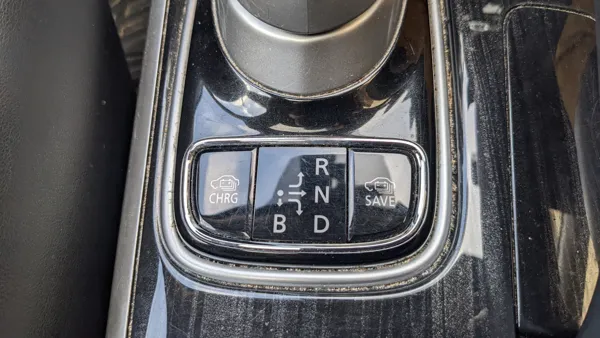At first glance, a hybrid powertrain can seem a bit like witchcraft. I still find it weird when the engine cuts out as I’m crawling along in traffic. The gut reaction when this happens is to dive for a nonexistent clutch, but as if by magic the car continues effortlessly, gliding up the hill!
Lets take a brief look at hybrid options and modes of driving.
Table of Contents
What is a Hybrid?
Hybrid, by definition, is a combination of two different elements. So e-bikes are hybrids – they have a human pedalling and an electric motor assisting. A hybrid car must have two power sources, electric motor and internal combustion engine to move it.

There is such a thing as a ‘micro’ hybrid. Essentially marketers have jumped on the ‘hybrid’ bandwagon, mislabelling a vehicle with an integrated alternator/starter. I say it is mislabelling, as the internal combustion engine is the only power source. Having a beefed up starter/generator does not technically constitute a hybrid by definition!
Energy Consumption Modes
So, for a hybrid powertrain with 2 power sources, there are various modes available to move the car, these are:
- Engine only – uses petrol
- Electric only – uses battery charge
- Hybrid mode, engine & electric motor – uses a combination of fuel and battery charge.
When the car is operating in hybrid mode, i.e. engine and electric motor operating together, there are 2 power delivery methods:
- Series – Engine runs a generator which charges the batteries, the batteries then power the electric motors. These are typically found in range extenders, eg. Chevrolet Volt. When you go to a rock concert, you must have seen a noisy smelly generator running to create electricity, the series hybrid is similar!
- Parallel – Engine runs and is coupled to the wheels via a clutch or transmission. The engine could also be charging the batteries. Most hybrids available are parallel hybrids, the most famous being the Toyota Prius. An E-bike could be thought of as a parallel hybrid, human pedalling (the engine) as well as the electric motor assisting.
Oil change frequency is actually quite important, check out this post about the importance of not skipping them. For more info on hybrid efficiency and the operating modes check out Why is a Hybrid Car More Efficient than a ‘Normal’ Car
Energy Saving / Acquisition Modes
A huge advantage of a hybrid is the ability to recover waste energy. A battery is able to store energy, this facilitates regenerative braking, capturing the kinetic energy of the vehicle and storing it as electrical charge. Conversely, vehicles without a battery typically have to convert kinetic energy (vehicle moving) into heat at the brakes – this clearly is less fuel efficient. The following 3 ways are how to get energy into the battery of a hybrid:
- Regenerative braking – motors charge the battery
- Engine – convert fuel energy to charge the battery
- Plug-in charging – AC electricity from the power grid to charge the batteries
When Does a Hybrid Switch to Petrol?
The ECU is a computer, it takes inputs from sensors and makes decisions. An example of some critical sensors/measurements in this decision making process:
- Accelerator pedal
- Battery state of charge (this isn’t really a sensor – another post on this to follow)
There are 2 key reasons that the hybrid controller will switch on the internal combustion engine:
- The traction drive battery has gone flat
- The driver has requested so much torque that the electric motors alone are unable to cope without engine assist eg.
- High speed
- High acceleration
- Steep hill
The engine control unit (ECU) will usually decide when to switch on the petrol engine -(there may also be a button that effectively forces the engine to run in some vehicles):

Can you Drive a Hybrid in Electric Only Mode?
Yes, you can. If you are striving for a hybrid that can drive in electric-only mode, a plug-in hybrid is probably the preferred option.
Plug-in hybrids eg. the Mitsubishi Outlander PHEV are usually the most capable when it comes to electric only speed and range. It is not the fact that you plug them in, more that they were designed with higher speeds and longer range in mind.
Non-plug-in hybrids such as the Toyota C-HR can do some limited low-speed driving in electric-only mode. Toyota are the pioneers of mass produced hybrid vehicles. They launched the infamous Toyota Prius back in 1997. Over the years, electric only mode has been getting faster and going further.
Unfortunately, not all hybrids are made equal. If you are looking for a hybrid that can drive in electric-only mode, you should certainly avoid a mild hybrid, eg. Ford Puma MHEV (or micro hybrid). Mild hybrids are essentially cars that have relatively small motors attached directly to the engine. Because of their size and design, they are only able to add assistance torque to the engine, they are not capable of driving the car without the engine also being on. Read more about this in my post ‘Ever wondered why hybrids never have manual transmissions?’
Is it Possible to Influence Engine Off Mode?
Yes, it’s possible and in some cars it is easier than others. The Toyota C-HR for example, has the option of EV mode in the form of a button. However, this doesn’t always mean that the car will remain in EV mode! Various other factors may dominate, eg. battery state of charge, or the driver requiring a burst of acceleration – forcing the car out of EV mode.
For vehicles without an EV button, there are a few tricks to encourage EV mode:

- Avoid using the heater in winter, favour things like heated seats and heated steering wheel. Heating the cabin requires so much energy the ECU will often choose the engine to generate heat.
- Gentle acceleration, I am now in tune with the amount of acceleration I can get away with before triggering the engine to burst into life.
Conclusion
The world of hybrids is fairly vast. There are many types, ranging from micro hybrids (which aren’t technically hybrids) all the way to plug-in hybrids, which are one step away from a fully fledged Battery Electric Vehicle (BEV). The type of hybrid you drive will massively influence the frequency and duration of the engine switching on. So, when wondering about when the engine on my hybrid will switch over to petrol, the answer is usually fairly predictable, a flat battery or a high torque situation is most likely to trigger that engine to fire up.
Gentle driving, plugging in your PHEV, and avoidance of the heater can all go a long way in prolonging that sweet EV drive distance.

